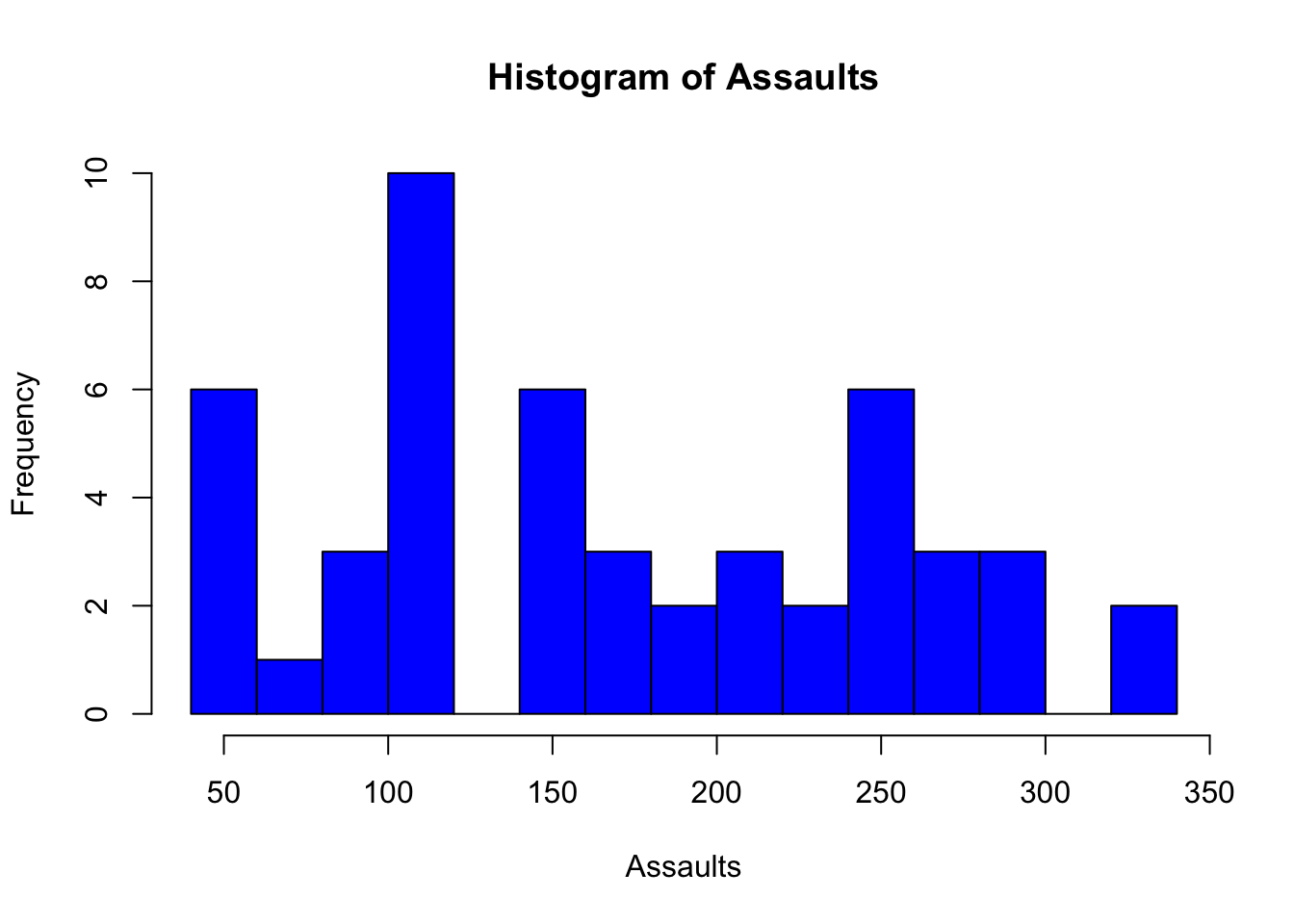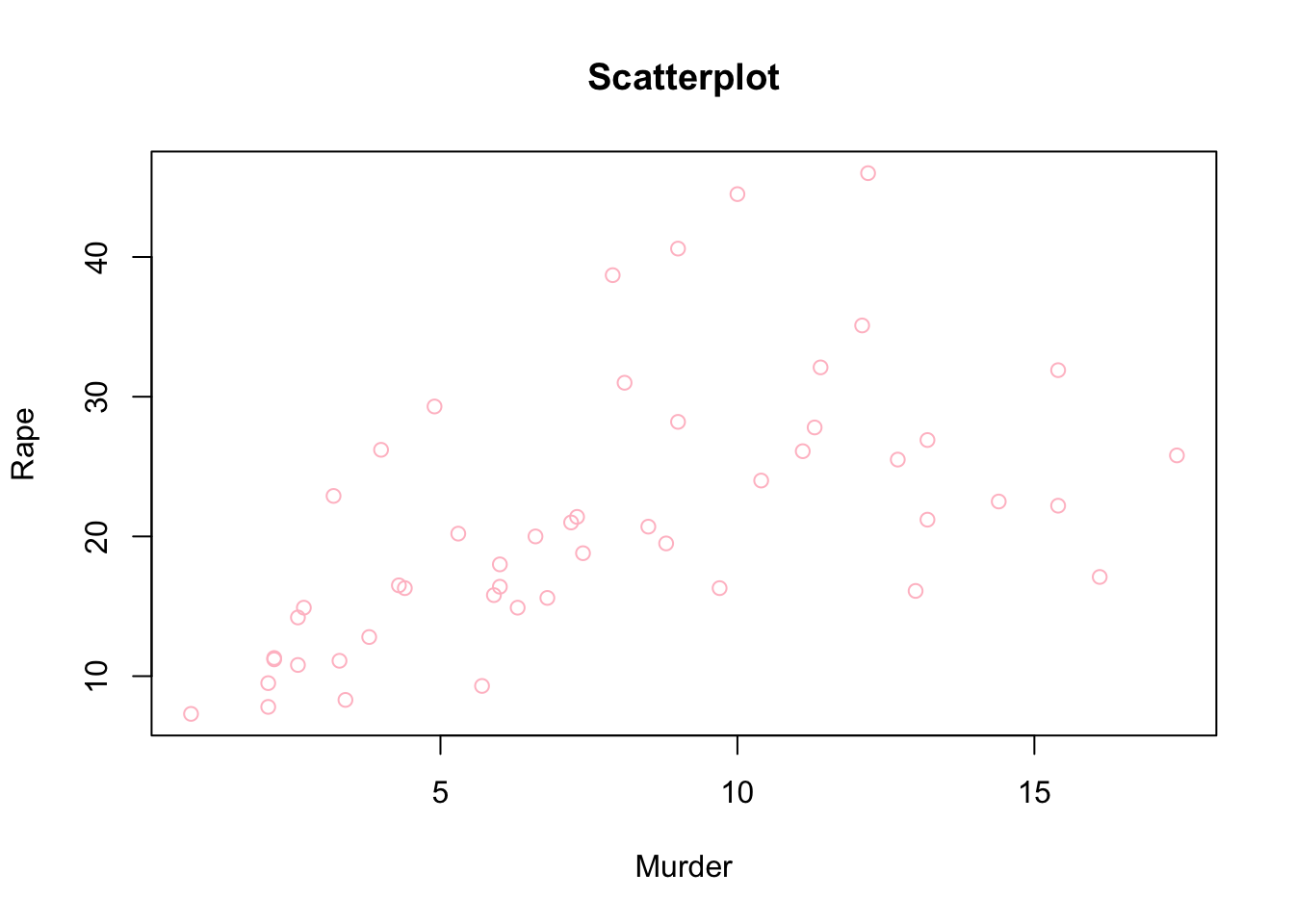49 hist, plot and boxplot
Written by Yena Joo and last updated on 7 October 2021.
49.1 Introduction
R has various functions to produce a wide range of graphics to visualize data. Visualizing data is the first step of any analysis, since it provides you the broad idea and distribution of data that helps you build your hypothesis, so it is important to know how to plot base graphs using R. With the basic functions that R provides, we can easily and quickly make different types of graphs within seconds.
In this lesson, you will learn how to:
- create a histogram using
hist()using various arguments. - other base graphing options such as scatterplots and boxplots.
- export the created base graphs.
Prerequisite skills include:
- Import dataset
- materials from the previous modules
- choosing the right variables to plot
Highlights:
49.2 Histogram: hist()
A histogram is a graph using bars of different heights, which shows the number of elements in each bin/category. It can also be called a frequency graph, where the y-axis is the frequency of the variable, and x is the range of the variable.
You can create a histogram using the hist() function. The function has many arguments to control things such as bin size, title, labels, colours, etc.
The function is composed of:
hist(x, breaks = "Sturges", freq = NULL, probability = !freq, include.lowest = TRUE, right = TRUE, density = NULL, angle = 45, col = NULL, border = NULL, main = paste("Histogram of" , xname), xlim = range(breaks), ylim = NULL, xlab = xname, ylab, axes = TRUE, plot = TRUE, labels = FALSE, nclass = NULL, warn.unused = TRUE, …)- x: a vector of values (ig. a column in a dataset).
- breaks: number, vector, function of breakpoints between histogram cells.
- main, xlab, ylab: title and axis labels.
Here is an additional information about the arguments you may find helpful.
Let’s work with an example with the built-in dataset called mtcars. Here are the first 6 observations of the dataset.
head(mtcars)
#> mpg cyl disp hp drat wt qsec vs am
#> Mazda RX4 21.0 6 160 110 3.90 2.620 16.46 0 1
#> Mazda RX4 Wag 21.0 6 160 110 3.90 2.875 17.02 0 1
#> Datsun 710 22.8 4 108 93 3.85 2.320 18.61 1 1
#> Hornet 4 Drive 21.4 6 258 110 3.08 3.215 19.44 1 0
#> Hornet Sportabout 18.7 8 360 175 3.15 3.440 17.02 0 0
#> Valiant 18.1 6 225 105 2.76 3.460 20.22 1 0
#> gear carb
#> Mazda RX4 4 4
#> Mazda RX4 Wag 4 4
#> Datsun 710 4 1
#> Hornet 4 Drive 3 1
#> Hornet Sportabout 3 2
#> Valiant 3 1Now let’s create the histogram using hist() function above.
hist(x = mtcars$mpg)
49.2.1 Number of Bins
You can change the number of bins to create a more accurate histogram since a large number of bins could hide important details about distribution which could make an error in the interpretation of the graph. To make a smaller number of bins, change the value of the argument breaks = into how many bins you want to set in the histogram.
hist(x = mtcars$mpg,
breaks = 20)
Another way is to put the exact break points in the argument.

49.2.2 Colour of the histogram
To change the colour of the histogram, use col = argument, such as col = "pink". The colour of the border of the bars could also be changed with the argument border =.
hist(x = mtcars$mpg,
breaks = 20,
col = "pink",
border = "blue")
49.2.3 Title and Axis
Once you are done fine-tuning the histogram, you can add your own title and axis labels using main, xlab, and ylab arguments.
hist(x = mtcars$mpg,
breaks = 20,
main = "This is a title",
xlab = "This is x-axis",
ylab = "This is y-axis")
For more specific arguments, you can always run help("hist") in the console to find more about the function.
49.3 Other base graphing options
49.3.1 Scatterplot
A Scatter plot is another good way to visualize the data. There are many ways to create a scatterplot in R, but this is the most basic and the easiest way to create a scatterplot, using the function plot(x, y). x and y arguments should be numerical values denoting (x,y) points. Using the same dataset, we can plot the scatterplot of mpg and disp as follows:
plot(x = mtcars$mpg, y = mtcars$disp)
To define the colour of the plot, you can use the argument col =.
The arguments are basically the same as when we create a histogram.
plot(x = mtcars$mpg, y = mtcars$disp,
col = "pink",
main = "This is a title",
xlab = "This is x-axis",
ylab = "This is y-axis")
Detailed descriptions of the arguments could be found here or type help("plot") in your console.
49.3.2 Boxplot
Boxplot is good for depicting groups of numerical data through their quartiles. The boxplot presents information such as median, minimum and maximum score, lower and upper quartile, and IQR. Boxplots also allow you to visualize the outliers and compare multiple distributions.
To create a boxplot, simply use the function boxplot().
boxplot(formula = mpg~cyl, data = mtcars)
Changing the colour, or labeling a title and axes is easy, the same as how we did for histograms and scatter plots. Also, you can use horizontal=TRUE to reverse the axis orientation.
boxplot(formula = mpg~cyl, data = mtcars,
col = "pink",
main = "This is a title",
xlab = "This is x-axis",
ylab = "This is y-axis",
horizontal = TRUE)
Detailed descriptions of the arguments could be found here or type help("boxplot") in your console.
49.4 exporting base graphs
Once you created a nice graph, you might want to save or export the graph. Set the file name for the plot you are going to save using the function jpeg(file = filename.jpeg), if you want to save it as a jpeg image.
For pdf files, use pdf(file = filename.pdf).
For png files , use png(file = filename.png).
We need to call the function dev.off() after plotting, which will return control to the screen.
We can set the resolution we want using the width and height arguments or set the full local path of the file we want to save if we don’t want to save it in the current directory.
49.5 Exercises
49.5.1 Question 1
Using the given dataset USArrests, create a histogram that depicts the distribution of assaults, set the bar colour to “blue” and set it to 15 bins. The title of the plot should be “Histogram of Assaults,” with the x-axis “Assaults.”
head(USArrests)
#> Murder Assault UrbanPop Rape
#> Alabama 13.2 236 58 21.2
#> Alaska 10.0 263 48 44.5
#> Arizona 8.1 294 80 31.0
#> Arkansas 8.8 190 50 19.5
#> California 9.0 276 91 40.6
#> Colorado 7.9 204 78 38.7
hist(x = USArrests$Assault,
col = "blue",
main = "Histogram of Assaults",
xlab = "Assaults",
breaks = 15) ### Question 2
### Question 2Save the plot you created in Question 1 as png file. The file name should be answer2.
49.5.2 Question 3
Create a scatter plot that depicts how the number of murders affects the number of rapes. Set the colour to pink, and the title of the plot should be “Scatterplot.” X and y axes should be labeled as the variable name.
plot(x = USArrests$Murder, y = USArrests$Rape,
col = "pink",
main = "Scatterplot",
xlab = "Murder",
ylab = "Rape")
49.6 Common mistakes & errors
Here are some common mistakes and errors you may come across:
- Do not confound histogram with a barplot. They are different plots, where histograms visualize the frequency of numerical data, and bar charts visualize categorical data.
- Bin size is important. Make sure you are using the right bin size.